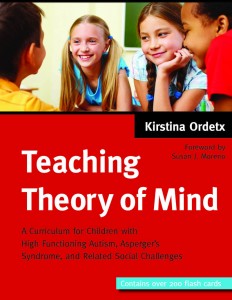Teaching Theory of Mind: A Curriculum for Children with High Functioning Autism, Asperger’s Syndrome, and Related Social Challenges by Kirstina Ordetx is a highly effective, easy-to-follow curriculum for teaching children with high-functioning autism, Asperger syndrome (AS) and related social challenges to relate to and interact with others successfully by developing a solid, basic foundation in Theory of Mind (ToM).
Teaching Theory of Mind provides an accessible overview of the key concepts of ToM, and explains how to assess each child’s readiness for the curriculum, suggesting practical ways in which to support those who do not yet meet the minimum criteria. Twelve 60-90 minute lesson plans for use with small or large groups of children aged approximately 7-16 are then presented, each of which is accompanied by a photocopiable letter to provide parents and caregivers with suggested activities for practicing and reinforcing the concepts and skills learnt at home.
Why Teach Theory of Mind?
Unlike concrete concepts, which are areas of strength for children with AS, the interpretation of others’ thoughts, feelings, and ever-changing behaviors is a far more abstract and transient concept. For these children, the ability to read social cues does not come naturally and must be taught. It is important to teach ToM for many reasons:
- Increased social problem-solving skills will generalize to other situations.
- Understanding others’ thoughts, feelings, and beliefs directly impacts regulation of the child’s own behavior.
- ToM moves a child’s state of awareness from a primarily egocentric perspective to a more socially sensitive state of being.
- Children gain increased ability to manage other socially induced problems, such as anxiety and rigidity.
This downloadable activity teaches children to identify feelings and label emotions by reading other people’s facial expressions or cues. During typical development, children watch other people express emotions and learn very early to recognize, read, and represent those emotions. The object of this activity is to enable the participants to identify feelings by reading important facial cues found in the eyes, the mouth, and the full face.